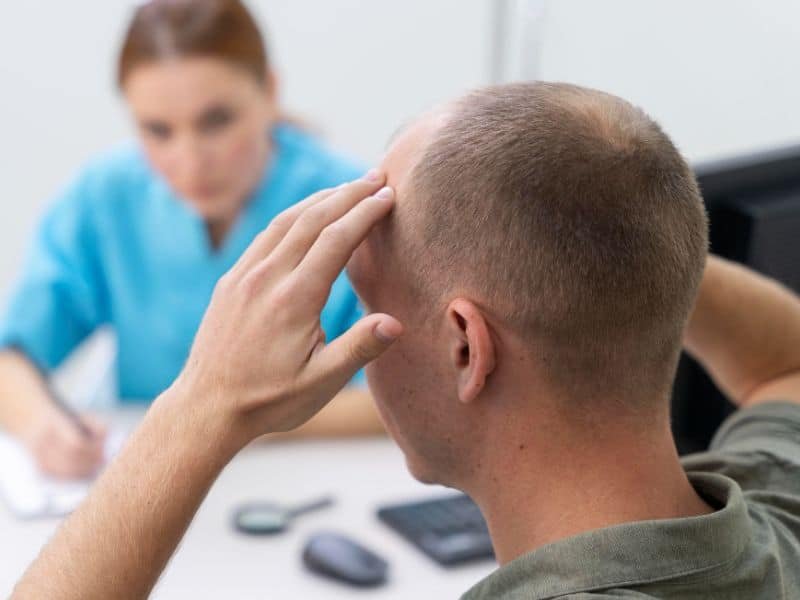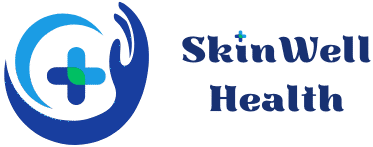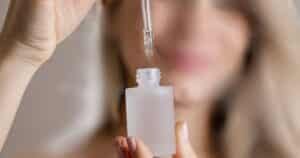Alopecia Areata: Top 9 Strong Causes: You Absolutely Need to Know
A common issue that effects individuals of all ages and genders is hair loss. Alopecia Areata is a condition that identifies itself as different types of hair loss due to its potential serious impact on an individual’s societal status and quality of life.
Alopecia Areata is an autoimmune disorder characterized by sudden, oval or circular patches of hair loss on the scalp or other body parts. It is important to understand the basic causes of this condition in order to diagnose and treat it effectively.
This article will discuss the 9 strong causes of Alopecia Areata with strong evidence that you absolutely need to know.
What is Alopecia Areata?
The word “alopecia” comes from the old Greek language and means “lack of hair” or “baldness.” In the medical field, the word “alopecia” defines any type of hair loss.
In the same Greek language, the word “areata” means “patchy” or “uneven.”
It means “patchy baldness” when you put these two words together.
People with the autoimmune disease alopecia areata lose their hair in smooth, round spots or patches on their heads and sometimes on other parts of their bodies as well.
Top 9 Strong Causes of Alopecia Areata
It’s not clear what causes alopecia areata exactly, but it’s believed to be a mix of genetic and environmental factors.
Here are 9 of the possible strong causes of alopecia areata:
1. 🧬 Family History & Genetic Link in Alopecia Areata
Recent research (2025) confirms that Alopecia Areata (AA) often runs in families. A large meta-analysis found that nearly 1 in 6 people with AA have a close family member who also experienced hair loss due to AA.
It’s clear now that both genetics and shared immune patterns play a major role — not just isolated cases.
📊 Key Findings at a Glance
Here’s what the research discovered:
| Factor Studied | Percentage / Result | What It Means |
|---|---|---|
| People with a family history of AA | 17.6% | About 1 in 6 people with AA have relatives with the same condition. |
| Prevalence among first-degree relatives (parents, siblings, children) | 3.22% | Stronger chance if a close family member has AA. |
| Prevalence among all relatives | 0.90% | The risk exists even beyond immediate family. |
| Thyroid disease in family members | 4.7% | Autoimmune connection is common. |
| Diabetes in family members | 10.1% | Suggests broader immune system involvement. |
| Atopic dermatitis (eczema) in family | 18.9% | Indicates allergic or inflammatory link. |
| Vitiligo in family | 5.5% | Often coexists due to similar immune mechanisms. |
| Other autoimmune diseases in family | 12.1% | Supports the idea of a shared autoimmune tendency. |
💡 What You Can Do
Ask about your family’s medical history — thyroid disease, vitiligo, diabetes, or eczema may be relevant clues.
Share this information with your dermatologist, especially if you or relatives have autoimmune conditions.
Support immune health through stress management, good sleep, and nutrition.
Stay informed — early awareness can guide better treatment choices and emotional support.
“Almost one in six people with alopecia areata have a family member affected by the same condition — a reminder that this isn’t just about hair, it’s about how our immune system behaves across generations.”
2. Autoimmune disease
New research from 2025 shows that Alopecia Areata (AA) isn’t just about hair loss — it’s strongly connected to how our immune system behaves. When the immune system becomes overactive, it can mistakenly attack the body’s own hair follicles and sometimes even other organs.
A large study reviewed thousands of people with AA and found that they’re much more likely to have other autoimmune conditions compared to those without AA.
Here’s what the research discovered:
| Condition | How Much More Common in AA Patients | What It Means |
|---|---|---|
| Vitiligo | ~6.6 times more common | Both share the same immune pathways that attack pigment and hair cells. |
| Atopic Dermatitis (Eczema) | ~2.6 times more common | Shows a link between skin inflammation and hair loss. |
| Autoimmune Thyroid Disease | ~1.6 times more common | Suggests immune imbalance affects both hair growth and hormones. |
| Systemic Lupus & Inflammatory Bowel Disease | Higher risk noted | Confirms AA is part of a broader immune response pattern. |
💡 What You Should Know
-
If you have Alopecia Areata, it’s a good idea to get screened for thyroid, vitiligo, or eczema, especially if you notice other symptoms.
-
Early detection of these autoimmune links can help manage overall health — not just hair loss.
-
Lifestyle choices like stress control, balanced nutrition, and sleep support your immune system and may reduce flare-ups.
“Alopecia Areata often travels with other autoimmune conditions — especially vitiligo, thyroid disease, and eczema — showing how deeply our hair health is tied to immune balance.”
Also Read:
3 Alopecia Areata Regrowth Signs: According to Alopecian
3. Stress
Stress doesn’t just affect your mood — it can directly impact your hair. Research (2025) shows that about 1 in 4 people with Alopecia Areata (AA) experienced a major emotional or stressful event before their hair loss began.
When we’re under stress, the body releases chemicals like Corticotropin-Releasing Hormone (CRH) and Substance P. These messengers can:
-
Weaken the hair follicle’s natural protection, allowing the immune system to attack it.
-
Trigger inflammation and push hair follicles into the shedding phase earlier than normal.
-
Increase oxidative stress, which further damages hair cells.
A large review found that stress and AA have a two-way link — stress can trigger AA, and living with AA can cause more stress, anxiety, and low confidence. In fact, nearly 74% of AA patients experience some form of mental health challenge in their lifetime.
💡 Takeaway
Managing stress is a key part of managing Alopecia Areata. Activities like meditation, exercise, proper sleep, and therapy help calm the mind — and may help protect your hair, too.
“Stress can awaken the immune attack behind Alopecia Areata — calming your mind can help calm your scalp.”
4. Hormone Changes
Hormones are an important factor in how hair grows and falls out. Some hormonal changes, like those that happen during childhood, pregnancy, and old age, can make Alopecia Areata worse.
Hair growth and the health of hair cells are both affected by the proper balance of hormones.
“Keep Calm It’s Not Cancer, It’s Alopecia Areata”
5. Infections
Some research studies suggest that viral or bacterial infections may cause alopecia areata. For example, Staphylococcus bacteria can cause folliculitis decalvans, or alopecia (folliculitis decalvans), in middle-aged people.

When the body’s immune system fights these infections, it can damage hair cells, which can cause hair loss.
Understanding which infections are linked to Alopecia Areata can help with advanced treatments.
6. Environmental Factors
The world is full of pollutants that are bad for our health and can even damage our hair. Having alopecia areata has been linked to growing up close to mercury and lead in the environment.

There are chemicals and poisons in the atmosphere that might gather on the scalp and stop hair growth.
Keep your head clean and healthy to stop hair loss.
7. Not enough food
A healthy, well-balanced diet loaded with important nutrients is essential for hair growth. Studies show that not getting enough vitamins, minerals, and fats may make hair loss worse.

While there is no proof that the diet does appear to be a direct cause of alopecia areata.
Some people with alopecia areata say that their symptoms get better when they eat well, though.
A healthy diet rich in iron, zinc, protein, and biotin helps keep hair follicles strong and healthy.
8. Hair care practices
Our hair and skin can be strongly affected by what we do during the day.
A lot of items that are used to care for hair, like styling tools, harsh chemicals, and hair products that are too harsh and can damage hair and create hair loss.

It’s important to keep in mind that these things only make hair loss happen, not alopecia areata directly.
Gentle hair care is beneficial for the health of your hair in general.
Also Read:
Best 9 Tips by Doctors: How to Alopecia Areata Self-Care
9. Medications and Smoking
Studies suggest that Alopecia areata may be linked to taking some medicines, like blood pressure drugs and beta-blockers.
Keep in mind that these medicines are used by many people who do not have alopecia areata.
People who smoke are more likely to get alopecia areata. Some people can lose hair cells or have an inflammation response when they smoke.
Studies show that people who smoke are more likely to have alopecia areata than people who don’t smoke.
Quitting smoking is good for your health and might lower your chances of getting alopecia areata if you are afraid about it.
Also Read:
Best 12 Natural Home Remedies for Alopecia Areata – SWH
Types of Alopecia Areata
Here are seven types of alopecia areata:
1. Alopecia Areata Monolocularis (Single Patch)
Definition: This type presents with a single, well-defined bald patch on the scalp.
2. Alopecia Areata Multilocularis (Multiple Patches)
Definition: Multiple bald patches scattered across the scalp.
3. Alopecia Areata Barbae (Facial Hair Loss)
Definition: Hair loss specifically in the beard area.
4. Alopecia Areata Totalis (Total Scalp Hair Loss)
Definition: complete hair loss on the scalp.
5. Alopecia Areata Universalis (Complete Hair Loss)
Definition: Hair loss extends to the entire body, including eyebrows and eyelashes.
6. Diffuse Alopecia Areata
Definition: Widespread thinning of hair across the scalp.
7. Ophiasis Alopecia Areata
Definition: Hair loss occurs in a band-like pattern along the sides and lower back of the scalp.
Treatments:
Due to the individual differences in alopecia areata, there is no singular “best” treatment. However, the following are some of the most known and effective options:
1. Intralesional corticosteroids
Corticosteroids are given by injection directly into the areas that are affected in order to promote hair growth and reduce inflammation.
Extremely effective for tiny sections, with 60-80% success rate data from studies.
2. Topical Immunotherapy
The application of sensitizing compounds, such as diphenylcyclopropenone (DPCP), produces a tailored allergic response, therefore redirecting the immune system’s attention from hair follicles.
Depending on the individual’s response, there is variable effectiveness; however, some patients may find success.
“I remember the first time I saw myself bald. My hair came out in the shower, kind of shocking. Know that everything else will fall into place. . .your hair will grow back, and having short hair for a woman is empowering, you feel free.”
By Nicole S.G.
3. Topical corticosteroids
Because they are not as strong as injections, topical corticosteroids may help with mild cases or the first stage of treatment.
They might not work as well as other options, and there isn’t enough proof to say for sure how well they treat alopecia areata.
Also Read:
How to Stop Alopecia areata from Spreading: You Need To Know
4. Minoxidil
Apply this drug straight to the scalp; it is available over-the-counter. People think that it works by creating more blood for the hair cells, which makes the hair grow.
It may take a few months for minoxidil to work, and it works best for people with mild to serious hair loss.
5. Phototherapy
In this treatment, ultraviolet light reduces the defense system and boosts hair growth. Phototherapy comes in two main types:
PUVA (psoralen and UVA) and UVB.
Most of the time, PUVA works better than UVB, but it also comes with a higher chance of skin cancer and sunburn.
6. Immunosuppressants
These medications work by suppressing the overall activity of the immune system. They are typically only used for severe cases of alopecia areata that do not respond to other treatments.
Immunosuppressants can have serious side effects, so they should only be used under the close supervision of a doctor.
7. Other treatments
There are a number of other treatments that have been used for alopecia areata, with varying degrees of success. These include anthralin, topical immunotherapy, and platelet-rich plasma (PRP) therapy.
More research is needed to determine the effectiveness of these treatments.
When to see a doctor

Not only is alopecia areata a physical problem, but it’s also a mental one. Talking to a doctor who can help with both the physical and mental sections is important for handling this condition well and improving your general health.
Bottom line
When dealing with Alopecia Areata, it can be hard, but knowing what causes it and what creates it can help people find new ways to avoid it and treat it.
People can improve their hair health and quality of life by taking care of genetic characteristics, immunity reactions, stress, chemical problems, and other issues.
Frequently asked questions
Q1. What is the main cause of Alopecia Areata?
The exact cause of Alopecia Areata is unclear, but some of them are genetics, immune system reactions, and outside factors.
Q2. Can stress alone trigger Alopecia Areata?
Stress can make the condition worse in people who are already more likely to get it, but it’s not the sole reason for Alopecia Areata.
Q3. Is Alopecia Areata an endless condition?
The recovery process for alopecia areata is different for each person. For some, hair may grow back on its own, while for others, they may lose even more hair.
Q4. Can a healthy diet help Alopecia Areata?
A healthy, well-balanced diet full of important nutrients can help your hair in general, but it might not help Alopecia Areata completely.
Q5: Are there any new ways to treat this disease coming up?
New treatment options are currently being investigated, such as tailored cures that change your immune response and help hair grow back.
Resources:
1. aad.org: Causes Of Hair Loss











